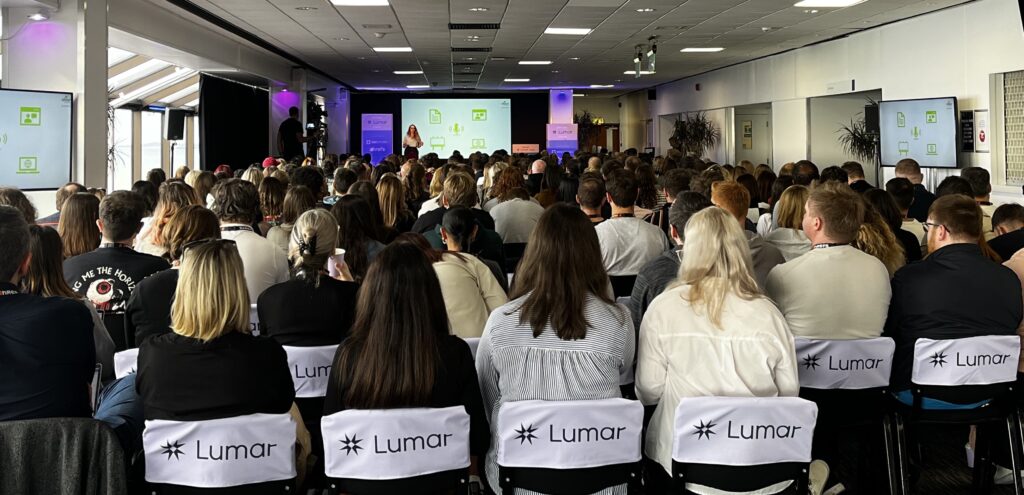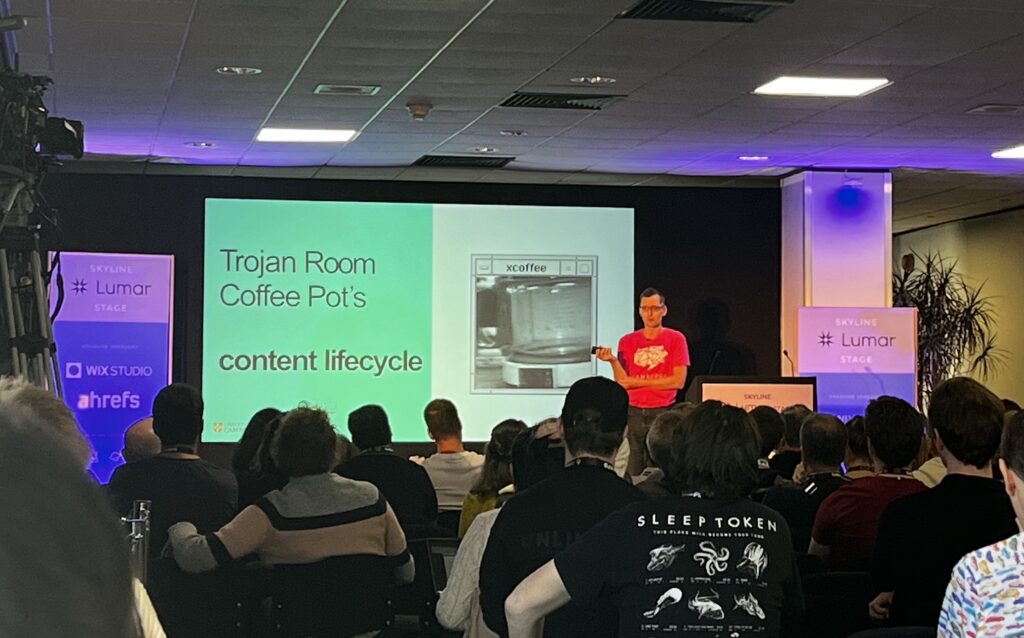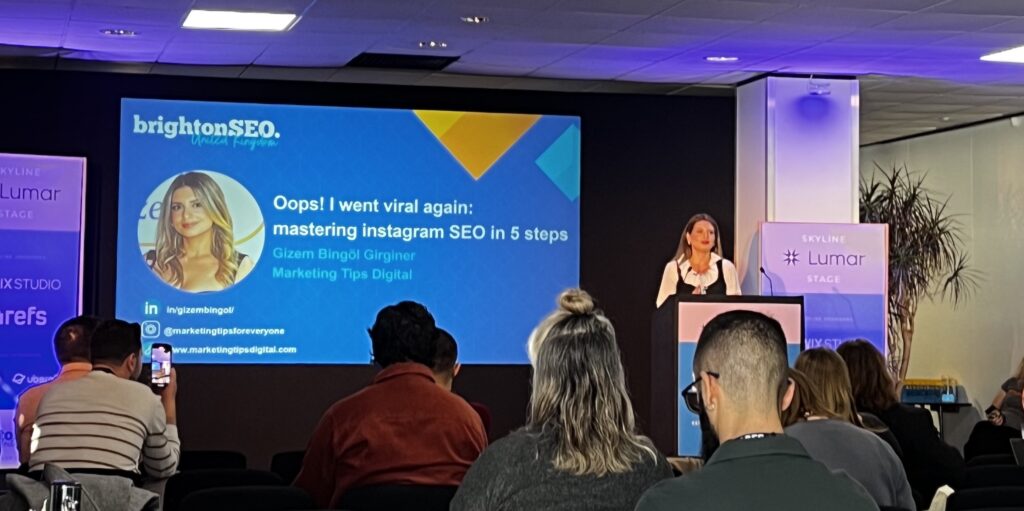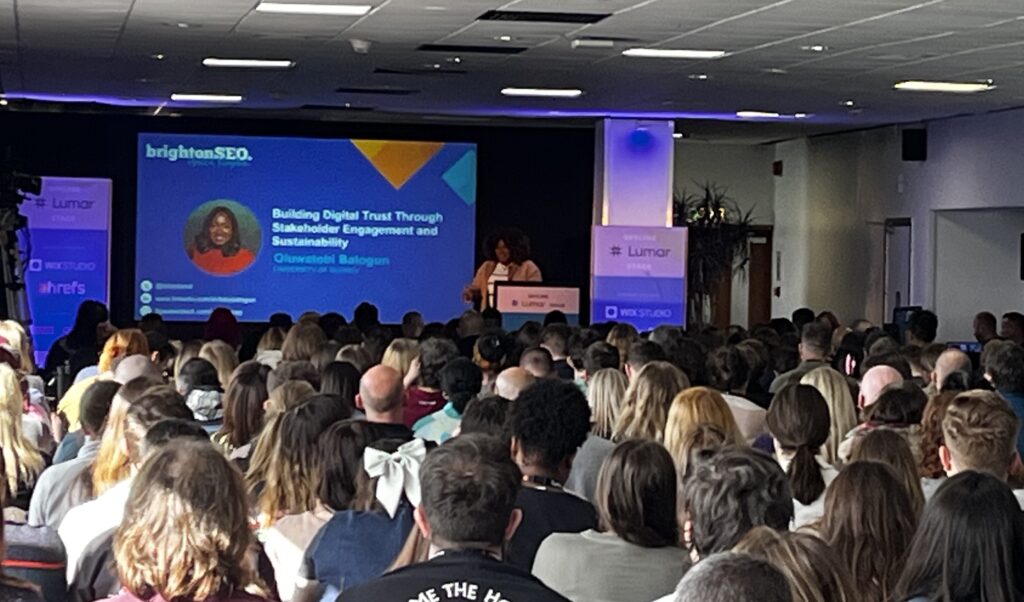Last week, thousands of SEO and digital marketing professionals gathered in Brighton for one of our industry’s biggest events of the year, BrightonSEO. At the Lumar Stage, we hosted 20+ speakers over two days — covering everything from actionable technical SEO tips to the impact of AI on website content strategies.
Here, we’re collecting some key takeaways on content strategies shared by the expert speakers who took to the Lumar stage last week.
Speakers include:
- Laura McInley, Content Strategist, Oban International
- Will Kerslake, Web Experience Manager, University of Cambridge
- Gizem Bingöl Girginer, Global Digital Marketing Strategist, Marketing Tips Digital
- Oluwatobi Balogun, Communications & Engagement, University of Surrey
- Ivana Flynn, SEO Director, Medier Agency / iGaming Inspiration
Top Takeaways: Content Strategy Tips from BrightonSEO 2024
- Getting the right content processes in place is vital for a well-functioning content program — especially for large-scale websites.
- Create processes for both content production and content deletion. Track your full inventory of content, who is responsible for what, and your timelines for project completion. Develop criteria for when and how to delete (and archive) content in the future to ensure users — and search engines — can find the most up-to-date and accurate information that they are searching for.
- Content today needs to expand beyond the confines of ‘Google SEO’ — more people are using social media platforms like Instagram and TikTok for search, as well as finding the information they are looking for on forums like Reddit.
- Website architecture needs to be a key component of your content program — make it easier for both users and search engines to navigate your content.
Laura McInley on how to set up and track your content production pipeline
Creativity, craft, and skill are all key aspects of content marketing — but you cannot overlook content logistics. The way you plan and structure your content production pipeline can have a huge impact on your team’s efficiency and effectiveness (not to mention overall stress levels!).
Getting the right content processes in place for content production can save you hours, reduce your team’s headaches and bottlenecks, and help you produce content at scale — without sacrificing quality.

Laura McInley, Content Strategist at Oban International, took to the Lumar stage at BrightonSEO to share her recommendations on how to build a better content production pipeline and how to scale your content program.
Step zero, she says, is knowing why you are making this content. Get your team aligned with broader company goals and the reasons you are making the content in your pipeline.
During the pre-production phase:
- Work out what content you need. To do this:
- Content Audit: Take inventory and audit your existing content — what’s there, what’s working, and what’s not working?
- KW Research: Conduct keyword research and keyword mapping.
- Competitor Analysis: Conduct a content gap analysis to see what content your competitors rank for that you either do not rank for or have not yet produced.
- Content Ideation: Based on your analyses and understanding of business priorities, processes, and campaigns, outline the content that you actually need. Then prioritize from there.
The production phase:
Once you have identified the content your team needs, you need to work out how you will produce it.
“If only it were a simple case of, ‘idea goes in, content goes out,” McInley says.
In reality, you need to get clear on your writers’ availability and schedules, determine which stakeholders may need to approve each piece of content, build in a QA and editing process, conduct keyword research and write a brief for each piece, and have processes in place for implementation — actually putting the content live on all of the channels you intend to distribute it on. (“For some reason, it always takes longer than everyone thinks,” notes McInley.)
Pull all of the above together and work out timelines for each content piece — that’s how you build your content production pipeline timeline.
Work backward from the date a piece of content needs to be published. After producing several pieces, you should have a general sense of what a ‘standard timeframe’ looks like for each type of content you regularly produce and can use these standard timelines to plan content at a larger scale.
Also, McInley stresses the importance of tracking your timelines and production schedules with a Content Tracker — some content managers may use Notion or Airtable for their content production tracking system, but a simple spreadsheet can work just as well.
When building out your content tracker, McInley recommends:
- Track every content piece in production — and which stage of production each piece is in.
- Use completion DATES rather than a simple ‘yes/no’ for each stage. This will help you establish your ‘standard timelines’, giving you a better understanding of where the bottlenecks are. It will also help you understand how long each stage of production typically takes, which will help you plan production timelines more accurately in the future.
- Get clear on who is responsible for updating the tracker — it doesn’t particularly matter who does it, but to ensure the tracker remains up-to-date, it’s important to establish whose responsibility it is.
- Hold regular check-in meetings to cover the progress of each content piece in the tracker and help untangle bottlenecks.
Scaling content production:
As you scale your content production, see where you can simplify your processes — for example, do multiple stakeholders really need to review and sign off on each article or brief before it’s finalized? Or can one editor be responsible for QA?
Batching content production can also help ensure you have a store of content to publish over the month/quarter/year. Batching content means you may sacrifice some ‘responsiveness’ to breaking news or trends, but can be useful for more evergreen content pieces. Smaller batches can help you retain some of that agility to be able to respond to new developments in your industry.
To scale, you’ll also need to work on effective resourcing — not every content lead has the budget or time required to source and onboard and train new freelancers or external writing teams
Will Kerslake on removing old content at scale
Creating new content is great — but sometimes, it is definitely possible for a website to have too much content. Especially when that website — or portfolio of connected sites — is an 800-year-old institution with thousands of people who have created content across its web properties for decades. Enter Will Kerslake, Web Experience Manager at the University of Cambridge, who faced this exact issue of addressing content decay on a massive scale.

As you might imagine, website governance for an 800-year-old university with multiple colleges and institutions attached to it is definitely a challenge. On the Lumar stage, Kerslake shared some of the tools and tricks he’s used along the way that helped him untangle an incredible amount of old, outdated, and scattered web content across 2,500 associated websites, 2 million+ pages, and over 1,300+ website editors.
When you have an “overgrown website,” he explains, there’s a reputational risk associated with having outdated information — and even potentially a legal risk of giving people the wrong information. On top of those risks, you’ll face issues with duplicate content, keyword cannibalization, and old, out-of-date content outranking your new pages in the SERPs. All of this leads to a poor user experience if people cannot find the information they actually want.
Ultimately, he says, we want to make it easier for users to navigate our website content — which will also make it easier for search engines. So, improving your site architecture is a great place to start.
He gives the example of trying to find the cost of studying English at the university next year — to find this information across their various web properties, the process was not at all intuitive and required sifting through English department pages, and seven other different departmental pages, before he eventually found the answer to his question on the ‘Academic and Financial Planning and Analysis’ website. And Google, it seemed, had a worse time of it, serving up 2018 tuition data from a PDF that was clearly outdated for next year’s student cohort. “But Google decided that was the best answer because we didn’t make it easy [for its search engine crawlers].”
He recommends taking a systematic approach to addressing content decay at scale:
1. Build your team and coordinate
Tackling this problem of content decay at scale required a lot of coordination — first, they had to identify all of the content owners across the 2,500 separately managed websites and bring them together to build a ‘community of practice’ across the institution. “Don’t go it alone,” advises Kerslake. At this scale, collaboration is key.
2. Get the data
Next, he suggests you get all of the relevant data you need to determine the full scale of the issue and what pages need to be evaluated for deletion. They’ve set up Google Analytics across all the various sites and can finally see the full extent of their website ‘estate’. When trying to funnel 2,000 websites into one GA4 property, he says, Google Tag Manager’s Lookup Table Variables can be a massive help.
3. Create an inventory of content
To properly inventory and crawl everything, Kerslake’s team is using Airtable to create a canonical list of every website they have under their umbrella — including data on what software and plugins and platforms they are using on each property.
4. Set clear criteria and audit your inventory
Once you have your full inventory of all the content, you can start to audit. First, determine what criteria you want in place to decide whether or not a web page gets culled, merged, kept, or updated.
You may want to consider what Kerslake terms “ROT” criteria — for redundant, obsolete, and trivial. If a piece of content falls into any of these categories, put it on the chopping block. Establish what data points can help you determine whether or not a piece of content falls into one of these “ROT” criteria — for example, you can crawl your site for any pages added over 10 years ago as a starting point. Using custom extractions in your website crawler can help you speed up this process.
Try to simplify the process as much as possible rather than falling into the ‘additive bias’ of assuming that adding something to an already large project will be the solution, he recommends.
Remove your ‘easiest targets’ first, he advises. (And, of course, remember to set up URL redirects for any content you delete.)
5. Archive
Keep a copy of the content you’re deleting from public view, Kerslake recommends. Often, it’s easier for stakeholders to stomach the idea of taking a web page down if they know a copy is being stored somewhere — even if it’s not live online.
(View Will Kerslake’s full BrightonSEO slide deck, “Retiring and removing content… at scale.” )
Gizem Bingöl Girginer on how to master Instagram SEO
Google isn’t the only tool that people rely on for search. Social media is increasingly used as a search tool, and understanding the unique algorithms of social platforms is key for SEOs and marketers who want to expand their organic search efforts to new spaces.

Gizem Bingöl Girginer, Global Digital Marketing Strategist and Founder at Marketing Tips Digital, took to the Lumar stage to share her top strategies for winning traffic and engagement on Instagram.
According to a survey of 2,000 Americans this year, 36% of people use instagram to search for content and information. Girginer also mentioned that 70% of Instagram users use its search tool to find content they want — up from 53% last year. And Instagram itself claims that “70% of shoppers look to Instagram for their next purchase.”
The recommendation engine on Instagram, Girginer points out, automatically provides content it thinks a given user will be interest in right below the search bar. The posts that get recommended here are based on engagement patterns and user behavior. Instagram’s focus on content relevance has made it essential for marketers to understand effective Instagram SEO strategies if they want to increase their brand’s visibility on the platform, she says.
To improve your chances of showing up in Instagram search and in its algorithmically-generated recommendations, she suggests:
1. Optimize your Instagram profile
Girginer says that profiles with optimized bios often see a 25% increase in follower growth and engagement.
- Choose a relevant username — include a relevant keyword for the topics you post about and the community you want to build.
- Use a high-quality, clear profile picture.
- Include the ‘why’ in your bio — why people should follow you, why they should click the link in your profile, etc. (For example, “Book 1 free session here” above the link in your profile.)
- Leverage ‘highlights’ to cover subtopics within your focus area and choose relevant names for these highlight collections.
2. Optimize the content you post:
- Create ‘SEO friendly’ content for Instagram.
- Identify your keywords — Similar to regular SEO, keywords in Instagram content can make a difference. You can use your standard KW research tools or even check what’s trending in the TikTok search bar and bring that over to Instagram.
- Add relevant keywords to your post caption.
- Add a geotag to your posts — this is another way people can find your content.
- Add alt text to your posts. (Instagram can generate alt text for your photos automatically, she says, but it is much better to write your own.)
- Add text to your cover image to tell people at a glance what is being shown in the post.
- Add trending music.
- Use subtitles on your Instagram videos.
- Use a strong CTA in your posts.
- Hashtags — Are hashtags dead? Hashtags are not dead, but they are not as important as they were 2-3 years ago, Girginer says. Branded/niche-specific hashtags can still enhance your brand reach and targeted engagement.
3. Building your tribe
All of your optimizations for Instagram search should start with understanding your audience, says Girginer. What content are they most likely to engage with? What times of day are they most likely to engage? Your content should entertain, educate, or solve problems for your audience. This last one, she says, is the best.
- Identify and follow key influencers, active users — and competitors — in your niche.
- Build authority through collaborations with influencers or UGC creators who align with your brand and have an engaged audience of their own.
4. Measure, test, and iterate
Girginer recommends constant testing and iteration — try things to see what works, what doesn’t, and adjust your Instagram strategy accordingly.
- Outline your key metrics for Instagram — reach, impressions, engagement, shares, etc.
- Get the right tools in place to track and measure your KPIs – this could be HootSuite, Sprout, etc.
- Adjust your strategy based on your results.
When it comes to ‘going viral’ on Instagram, Girginer says this shouldn’t be your ‘ultimate goal’, though it can be a nice boost when it happens. Be a trend-setter, not a trend-follower, to achieve viral reach — and follow Instagram SEO best practices to ensure your content is discoverable and set the stage for virality in the future.
Oluwatobi Balogun on building trust online through sustainability content and stakeholder engagement
More than ever, customers, partners, and external stakeholders expect transparency, ethical practices, and meaningful engagement from their business partners. Oluwatobi Balogun, a communication and engagement professional at the University of Surrey, discussed the importance of effectively communicating information about your business’s sustainability and social responsibility programs to build trust online.

79% of consumers are more likely to trust a brand that is environmentally and socially responsible, Balogun shared, citing a study from the Capgemini Research Institute. And businesses, it seems, have taken note. B Corp certification is one way to signal ESG (Environmental, Social, and Governance) impact, and the number of companies seeking B Corp certification is growing. There are now over 2,000 B Corps in the UK — and over 8,000 B Corps worldwide — a notable increase from 2022 numbers.
“Establishing trust as a sustainable brand is crucial,” says Balogun. Consumers are well aware that ‘green washing’ is a thing — and are becoming more savvy about judging businesses’ true impact on both the environment and society at large.
And chances are, for the 77% of consumers who say they are more motivated to purchase from companies committed to making the world better, according to an Aflac CSR survey, they will find this information about your business online — either through search or your website content.
Establishing trust with your online customers helps build long-term relationships, Balogun notes. For companies that want consumers to know about their sustainability and ESG programs, this means creating high-quality content around these topics. Balogun also notes that search engines prioritize sites that offer valuable, trustworthy content (EEAT) — from an ESG perspective, this might mean creating detailed, transparent sustainability reports about your company’s efforts in this space.
Balogun also recommends SEO and website teams take a direct role in contributing to their companies’ broader sustainability efforts, for example, by working with web hosting companies that run on renewable energy.
Ivana Flynn on how to get website traffic from Reddit

This year, Reddit has been discussed a lot in SEO circles. Its prevalence at the top of the SERPs lately is hard to ignore. So, how can SEOs and marketers take advantage of Reddit’s popularity to build community and drive traffic to their own websites — without getting their accounts destroyed by downvotes and deletion?
Ivana Flynn, SEO Director at iGaming Inspiration, shared her experiences with Reddit from an SEO perspective and provided her top tips for success on the platform.
Step one to building a brand presence on Reddit, says Flynn, is building your ‘karma’ on the platform so your posts are actually seen. Karma (on Reddit) equals growth. “When you open a Reddit account, your karma is ‘1’,” she explains. You need to build it up over time — by engaging with other posts on the platform and writing your own posts. Consider what you are an expert in and post about that in relevant subreddits, she suggests. Or consider trending news topics and post helpful information about those stories — Flynn gave the example of posting a schedule of all Simone Biles appearances during the Olympics. And if all else fails, don’t underestimate the power of cute animals — Flynn’s posts about her pets (with images!) have helped her build karma for her accounts.
Once you’ve built some karma for yourself on Reddit, you’re likely to get more engagement on the platform. But you need to be cautious when promoting a brand, business, or services — your posts can still easily get removed if you’re posting on someone else’s subreddit and they don’t allow self-promotion (many sub-forums do not like or allow brand-promoting posts). So, Flynn says, you need to be “extremely, extremely creative” in how you approach Reddit as a brand. Some ‘creative’ approaches Flynn discussed included:
- Guerilla Marketing — Embed your marketing or brand awareness attempts in other, more useful, or creative projects. She gives the example of creating a YouTube channel of herself playing slot games to build community around gaming and casino-related topics.
- Infiltration Marketing — Become a valued member of an existing subreddit through lots of useful, non-promotional posts.
- Create a Non-Branded Community — Create your own subreddit on a topic related to your business or brand as an actually helpful community.
“Long-term strategy and churn-and-burn don’t go together,” Flynn warns. If you are absolutely determined to post promotional content on Reddit in an attempt to create some short-term gains, be absolutely prepared for the account you do this with to get shut down. Definitely don’t do it under your primary account, she warns.
Reddit can also be a great source of inspiration for topics to cover on your own blog or website, Flynn says. Look for ‘blue ocean’ opportunities within topics that are being actively discussed on Reddit but do not yet have much competition in the organic SERPs. When you’re engaged with the niche communities on Reddit for topics related to your offering, you can find endless topics to cover on your website that are proven to be relevant and interesting to your niche, she suggests.






